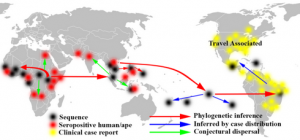ZikaResearchers projecting epidemic’s spread say Zika cases are under-reported
With the report from Florida governor Rick Scott on Monday that fourteen people in the state have been infected with the Zika virus most likely through mosquito transmission, the concern about outbreaks in the United States has intensified. A new study, along with interactive maps, provides current numbers as well projections for the number of Zika cases in the Americas through January 2017. It also provides projections for the number of microcephaly cases associated with the disease through October 2017, a date chosen to allow for the nine months of pregnancy.

Zika phylogenetic analysis map // Source: commons.wikimedia.org
With the report from Florida governor Rick Scott on Monday that fourteen people in the state have been infected with the Zika virus most likely through mosquito transmission, the concern about outbreaks in the United States has intensified. The news comes on the heels of new research by Northeastern professor Alessandro Vespignani that can help countries in the Americas plan a response.
Northeastern reports that the new study, along with interactive maps, provides current numbers as well projections for the number of Zika cases in the Americas through January 2017. It also provides projections for the number of microcephaly cases associated with the disease through October 2017, a date chosen to allow for the nine months of pregnancy. Microcephaly is a serious neurological birth defect characterized by a smaller than normal head.
The research is a collaboration overseen by the Center for Inference and Dynamics of Infectious Diseases, a Models of Infectious Disease Agent Study Center of Excellence funded by the National Institutes of Health.
Tackling Zika has been “a call to arms,” says Vespignani. “We’ve been working on the modeling around the clock since January,” adds Matteo Chinazzi a postdoctoral research associate in Vespignani’s laboratory for the Modeling of Biological and Socio Technical Systems, or MOBS, and a coauthor of the study.
The team of fourteen researchers uses large- scale computational epidemic models that integrate socio- demographic and travel data of target populations along with simulations of infection transmission among millions of individuals to reconstruct disease spread in the past and project it into the future.
Number of reported cases may be just the tip of the iceberg
Under-reporting is rife in affected countries because up to 80 percent of people with the disease are asymptomatic, says Vespignani, Sternberg Distinguished Professor of Physics and director of the Network Science Institute at Northeastern. “Even of those with symptoms, probably only one- third will go to the doctor and get diagnosed,” he says.
Indeed, the number of travel- associated cases of Zika in the United States reported by the Centers for Disease Control and Prevention may be just the tip of the iceerg, according to the research.
